How To Measure For Window Blinds Perfectly - The Complete Guide
- Real Blinds Australia
- Aug 4, 2020
- 10 min read
Updated: Aug 1, 2022
Do you want to measure up for blinds with pinpoint accuracy?

Well, of course you do…who would ever want their blind measurements too small or too large?
There’s countless blogs & companies out there trying to explain how to do this, but which one has the best advice?
Most other blind measuring blogs only mention about internal or external mount, but there are more locations and considerations than just this.
Measuring your property for blinds might seem daunting at first, but I’ve come up with a complete guide that is easy to use that you can get perfect blind measurements any place any time.
I will explain to you the different locations to install blinds like internal, external, ceiling mount. Then I’ll go through with you how to measure blinds for all types of scenarios starting with the basics of measuring for most blinds, measuring between tiles, sliding doors, bi-fold doors, bay windows and more.
Measuring the width can vary between types of blinds and installation locations. However, measuring for heights is generally the same processes throughout.
Note that the material of a roller blind is 35mm smaller than the measurement you provide. Provide us with the total dimension and we will make all the deductions.
If you follow this guide and don’t achieve your desired results, you can get in touch and I will personally walk you through how to measure for blinds in your place.
Step 1 – Where to install
Step 2 – Measuring the width
Step 3 – Measuring the height
You will need a metal tape measure and either a pen and paper or smartphone to take down dimensions.
Ready?
Step #1: Deciding on the best location to install the blind
I have come across hundreds of factors that would impact, which location you should choose to hang your blinds. About 98% of blinds I see are in the correct location, however, a large number of blinds are installed into the wrong location.
So, which blind location is going to suit your blinds?
Internal mount – This is ideally where you want most of your blinds to be to achieve a clean look. For square set windows, you should if practical chose to put your blinds inside of the window. This will give your blinds a flush look, when down, in line with the wall and make the blinds look more a part of the window instead of an extension.

External mount – The blind is to be mounted to the outside of the window frame overlapping all sides. This option can provide you with additional darkness, privacy and can cover an unattractive window. This is common in bedrooms, nurseries, theatre rooms, if you bought a ready-made blind that won’t fit internally, windows that are not deep enough, or if internal mounting is just not an option.
Some roller blind options have a different backing material and are not recommended to be reverse rolled, which in some cases are better installed internal mount.
TIP - For additional coverage, on the measure add an extra 10mm each side to increase coverage of the blind.

Windows with an architrave – Some older or classical style properties have architraves around their windows. The blind is to be mounted on the outer flat part of the architrave

Between tiles – Usually an internal mount, especially if there is cabinetry obstructing an external mount. See step two for further details on measuring.

Into tiles - If you can avoid installing into this location that will eliminate the risk of cracking a tile. An alternative to this location is done by extending out the bracketing from the window and installing into the aluminium frame. Installing blinds onto tiles is possible if done correctly, but you always run the risk of a tile cracking during installation.
Sliding doors internal mount– Most sliding doors have a mullion, which is a bar that sticks up and can obstruct a roller blind from being internally mounted. Sometimes you can mount the blind further out from the window to avoid the mullion.
If not, the solution is to get a pencil, masking tape, a hacksaw and step ladder and draw a diagonal line, then slowly standing on the step ladder cut the top of this pieces off. This is best done when you have the blind, which with some types of blinds you can use the brackets as a measuring guide of how much to take off, otherwise use the blind itself to test. Make sure the blind has at least 2mm clearance when it is fully rolled up and the door can slide without touching the blind or the bracket.
It's a safe practice to use a strip of masking tape along the front to stop the hack saw sliding down and scratching the paint off the lower part of the mullion. In Step two I will discuss how to measure for both sliding doors and bi-folding doors.


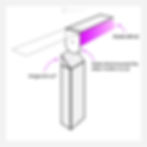

Ceiling mount – Most common for curtains or, windows or doors that go right up to the roof.



Round, parallel or unusual shaped windows – These windows have a limited amount of options for coverings. Some products that could work are Vertical Blinds, Custom Shutters or Panel Glides. It is quite common that these types of windows that do not have a privacy or sun issue get no covering at all.
When selecting your location here is a list of things to consider that may obstruct your blind.
CHECKLIST FOR OBSTRUCTIONS

One further consideration that may obstruct your blind is the depth measurement allowed to fit your blind, and here is a table to help.
DEPTHS

Now that you have a better understanding of where a blind should be mounted, let’s get straight into the measuring.
Step #2: Measuring the width of the area requiring a blind
Measuring basics for internal / external mount and windows with architraves
So, let’s begin with the basic and most common technique to measure. This is the approach you can use to measure the width for most types of blinds in most scenarios. Afterwards, I go into details of other techniques to use in less common scenarios.
So, get your tape measure out and extend the measure end out to the point you want the blind to begin.



Now, I want you to extend the tape measure past the point you want to measure and take a reading in millimetres.
This photo shows you that you hold the tape when it's extended out over the point you are measuring. You will need to take the millimetre dimension.
1m=1000mm | 50cm=500mm | 10cm=100mm | 5cm=50mm | 1cm=10mm
An example of a blind width measurement would be like 2403mm or 1802mm
So, write down the measurement you took. Now, just like you did before, do the same thing and get the measurement for the top, middle and bottom.

Now, out of the 3 measurements you have taken I want you to discard the two larger measurements and only keep the smallest measurement. Most windows or frames are not straight and it's common you will see variation, so the safest option is to go with the smaller dimension.
If you ordered a blind that was too big, unless you’re an expert you shouldn’t cut it down. However, if you ordered a blind that was too small, if it's less than about 15mm, well this is within tolerance and acceptable to hang. Just make sure a short blind has its gaps even on both sides, so if it's 14mm too small have an excess 7mm gap either side.
In most cases, this technique will work for all of your blinds so feel free to skip to step 3 where we will discuss measuring the height.
Measuring for blinds between tiles
It’s common in kitchen and bathrooms to have tiles, which in window areas are usually part-way up your recess. For most blinds take a measurement between the tiles on opposite ends.
For roller blinds take a measurement between the walls. If the difference between the tile and between the dimension of the wall is 25mm or more than use the tile to tile dimension. Keep in mind to base rail of the roller blind width is 30mm less than the wall to wall measurement you take.

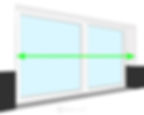
Measuring for blinds on sliding doors
Refer to Step 1 for the process to remove the top of the mullion, which is a common obstruction for internal mounting roller blinds in sliding doors. For multiple blinds inside the frame of a sliding door, first make sure the door is fully closed. Then you take a measurement from the side to the middle of the mullion in the door. Avoid the gap of separate roller blinds falling with glass behind them as this will create a significant light gap between them and not look correct, always have blind brackets meeting together at the middle of the width of the mullion.
For multiple blinds take individual measurements and do not divide from a total measurement, because this is not always accurate.
If you have any questions about measuring for sliding doors, you can give me a call and I’m happy to provide details on how to measure for this.
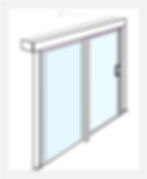

Measuring for roller blinds on bi-fold doors
B-fold doors commonly will have 5 panels. To avoid an issue of a chain hanging down when the doors are fully opened up and the roller blinds are up, you should aim to cover this space in two roller blinds. The smaller roller blind should be on the doorway section.
Most roller blinds are limited to 3000mm, I have a solution for a view screen that is up to 3200mm. For multiple blinds take individual measurements as dividing total measurements is not always accurate.
If you have issues covering this space with two roller blinds and require 3 roller blinds. Measure one small roller blind for the main door and two roller blinds for the two sets of other doors. If you have an even number of panels you should measure in twos.

Measuring for blinds on angled bay windows
Bay windows are a much more challenging area to measure for as the dimensions will be varying for different types of blinds and the be different angle each window is on.
A simple solution would be to get us to do a free measure Sydney & Melbourne wide, or take all the widths dimensions to each side, and send these to us with plenty of photos and we will be able to work from there.
Otherwise here is a technique that can be used to get accurate angled bay window dimensions. You will need your tape measure, two pieces of A4 paper and a pencil.

Step 1
Get your pen and the two pieces of A4 paper. Draw a dot on the long edge at the measurement projected for the type of blind you are interested in on both pieces of paper. The projected measurements are just below.

Step 2
Put the two dots together and line the paper up flat on the bay window where to windows meet.

Step 3
In-between, where the two dots are on the paper mark a dot in pencil on the floor or where the countertop, is.

Step 4
Once you have marked up all your dimensions you can now use this to get all your width dimensions.

Note that you must take into account potential obstructions. Also, some Roman Blinds can be obstructed when they fold going up, check with a professional before ordering.
Here is the table for the measurement projections.
Angled Bay Window Projections

Measuring for blinds on boxed bay windows (right angles)
This is a situation of a window where two blinds meet at a 90-degree angle. One blind will go the full width (through blind) and one will have its width shortened (butt blind). The through blind is usually the larger blind. The only time the smaller blind is the through is when the smaller is much more visible than the larger blind. If the blinds are similar size the through blind should be the most visible blind.
The visibility of a blind is how often you will see the blind, which is mostly determined by the main traffic areas of a room or where most of the walking in the room will be, also where the bed is situated.


Take the full dimensions for both the through blind and butt blind areas and deduct the following dimensions from the butt blind.
Butt Blind Reductions

Measuring for blinds on doors with glass
If you have a door that has glass on the door itself it's most common to put Venetian or Roller blinds on the door. They are usually mounted to cover the glass but fall behind the handle. Note that Roller blind material is 35mm smaller than the measurement you take, and Venetian blinds are 10mm smaller than the dimension you take.
In most doorway scenarios you should try to mount a blind onto the door, so the door has full functionality without being impacted by the blind. In some cases it may look nicer to have the blind on top of the door on the door frame, although the issue is to use the door the blind has to be pulled up, whereas if it was mounted onto the door, whether up or down you can still go in or out of the door.
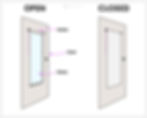
Measuring for blinds on windows that are high up or hard to access
If you can reach over the stair railing and measure the window this is preferable. If not, use a step ladder or ladder to get access to the window. If you can’t reach the top of the window take the bottom dimension of the window frame. Measuring on the wall below a high window and estimating the width is very risky and I would not recommend you do this.
Your three options to operate, or not, this high up blind is:
Option 1 – The blind is left closed and is not accessible to use.
Option 2 – The blind has an extra-long chain, cord or string which falls down the wall to a reachable spot below. White chains are usually more subtle.
Option 3 – Motorise the blind. This is the most expensive option.
TIP – When using an extension ladder to protect your wall, window frame or window mullion, put a folded towel on the top of the ladder. Make sure your ladder is stable. Preferably have someone assist at the bottom of the ladder. Always keep 3 points of contact and stay in the middle of the ladder. Finally, always take further precautions and safety measures when using a ladder.
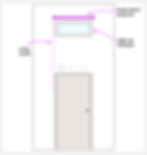
Step #3: Measuring the height of the area requiring a blind
With the skills you learnt measuring the width, apply this to the height. You should take 3 measurements for the height. Left side, middle and right side. Keep the shortest measurement and dispose of the larger ones. Roller blinds keep the larger dimension.


TIP – If the window or doorway you are measuring is too high for the tape measure to reach and you don’t have a step ladder here is a technique with the tape measure sure to help you out.

Conclusion
Did you find the information you were looking for, if not, what other information would you like me to provide? Do you feel confident in going out and measuring for blinds? Let me know in the comments and I’ll be sure to reply.
Also, have a friend who might need a hand with blinds, you can share with them, this post and I personally will be able to help them out.
If you want to eliminate the stress of measuring, you can book a free measure and quote Sydney & Melbourne wide at Real Blinds. We also supply all types of blinds and offer expert installation services and advice Melbourne & Sydney wide, see our website or simply google Real Blinds for further details.
Written by
Noah Radford
Senior Blind Expert
Visit https://www.realblinds.com.au or call 1300 215 388

This blog is regarding only the blinds mentioned in this blog and no other types of window coverings. The person or party who measures is solely liable for any issues that may arise with the blinds due to the blind sizes being too big or too little or the blinds unable to function correctly due to their sizing. Any use of step ladders, ladders, or hacksaws is at your own risk. If in doubt contact a professional, I’m happy to provide free advice.